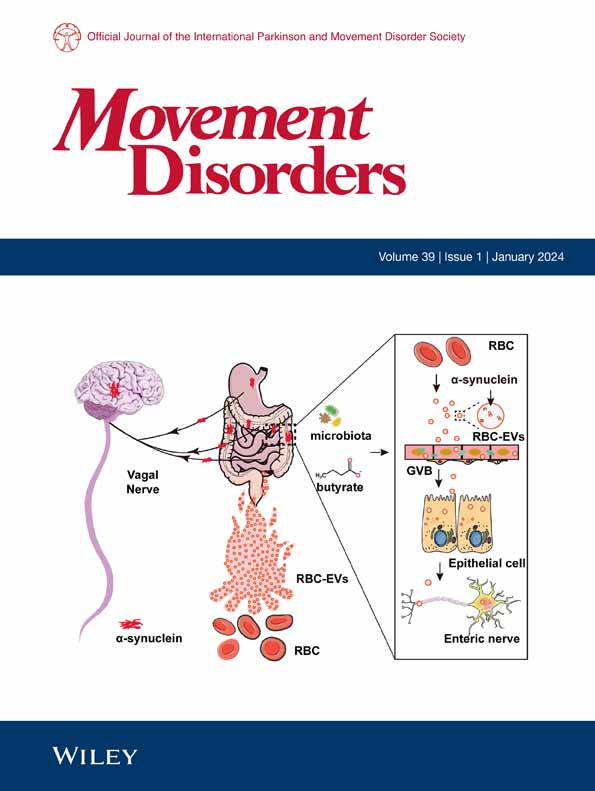Nicola M. Slater PhD, Tracy R. Melzer PhD, Daniel J. Myall PhD, Tim J. Anderson MD, FRACP, John C. Dalrymple-Alford PhD
下载PDF
{"title":"Cholinergic Basal Forebrain Integrity and Cognition in Parkinson's Disease: A Reappraisal of Magnetic Resonance Imaging Evidence","authors":"Nicola M. Slater PhD, Tracy R. Melzer PhD, Daniel J. Myall PhD, Tim J. Anderson MD, FRACP, John C. Dalrymple-Alford PhD","doi":"10.1002/mds.30023","DOIUrl":null,"url":null,"abstract":"<p>Cognitive impairment is a well-recognized and debilitating symptom of Parkinson's disease (PD). Degradation in the cortical cholinergic system is thought to be a key contributor. Both postmortem and in vivo cholinergic positron emission tomography (PET) studies have provided valuable evidence of cholinergic system changes in PD, which are pronounced in PD dementia (PDD). A growing body of literature has employed magnetic resonance imaging (MRI), a noninvasive, more cost-effective alternative to PET, to examine cholinergic system structural changes in PD. This review provides a comprehensive discussion of the methodologies and findings of studies that have focused on the relationship between cholinergic basal forebrain (cBF) integrity, based on T1- and diffusion-weighted MRI, and cognitive function in PD. Nucleus basalis of Meynert (Ch4) volume has been consistently reduced in cognitively impaired PD samples and has shown potential utility as a prognostic indicator for future cognitive decline. However, the extent of structural changes in Ch4, especially in early stages of cognitive decline in PD, remains unclear. In addition, evidence for structural change in anterior cBF regions in PD has not been well established. This review underscores the importance of continued cross-sectional and longitudinal research to elucidate the role of cholinergic dysfunction in the cognitive manifestations of PD. © 2024 The Author(s). <i>Movement Disorders</i> published by Wiley Periodicals LLC on behalf of International Parkinson and Movement Disorder Society.</p>","PeriodicalId":213,"journal":{"name":"Movement Disorders","volume":"39 12","pages":"2155-2172"},"PeriodicalIF":7.4000,"publicationDate":"2024-10-03","publicationTypes":"Journal Article","fieldsOfStudy":null,"isOpenAccess":false,"openAccessPdf":"https://onlinelibrary.wiley.com/doi/epdf/10.1002/mds.30023","citationCount":"0","resultStr":null,"platform":"Semanticscholar","paperid":null,"PeriodicalName":"Movement Disorders","FirstCategoryId":"3","ListUrlMain":"https://onlinelibrary.wiley.com/doi/10.1002/mds.30023","RegionNum":1,"RegionCategory":"医学","ArticlePicture":[],"TitleCN":null,"AbstractTextCN":null,"PMCID":null,"EPubDate":"","PubModel":"","JCR":"Q1","JCRName":"CLINICAL NEUROLOGY","Score":null,"Total":0}
引用次数: 0
引用
批量引用
Abstract
Cognitive impairment is a well-recognized and debilitating symptom of Parkinson's disease (PD). Degradation in the cortical cholinergic system is thought to be a key contributor. Both postmortem and in vivo cholinergic positron emission tomography (PET) studies have provided valuable evidence of cholinergic system changes in PD, which are pronounced in PD dementia (PDD). A growing body of literature has employed magnetic resonance imaging (MRI), a noninvasive, more cost-effective alternative to PET, to examine cholinergic system structural changes in PD. This review provides a comprehensive discussion of the methodologies and findings of studies that have focused on the relationship between cholinergic basal forebrain (cBF) integrity, based on T1- and diffusion-weighted MRI, and cognitive function in PD. Nucleus basalis of Meynert (Ch4) volume has been consistently reduced in cognitively impaired PD samples and has shown potential utility as a prognostic indicator for future cognitive decline. However, the extent of structural changes in Ch4, especially in early stages of cognitive decline in PD, remains unclear. In addition, evidence for structural change in anterior cBF regions in PD has not been well established. This review underscores the importance of continued cross-sectional and longitudinal research to elucidate the role of cholinergic dysfunction in the cognitive manifestations of PD. © 2024 The Author(s). Movement Disorders published by Wiley Periodicals LLC on behalf of International Parkinson and Movement Disorder Society.
帕金森病的前脑基底胆碱能完整性与认知:磁共振成像证据的再评估》。
认知障碍是帕金森病(PD)的一种公认的衰弱症状。大脑皮层胆碱能系统的退化被认为是一个关键因素。尸体解剖和体内胆碱能正电子发射断层扫描(PET)研究为帕金森病中胆碱能系统的变化提供了宝贵的证据,这些变化在帕金森病痴呆症(PDD)中更为明显。越来越多的文献采用磁共振成像(MRI)这种无创、成本效益更高的方法来研究 PD 中胆碱能系统结构的变化。本综述全面讨论了基于 T1 和弥散加权 MRI 的胆碱能基底前脑(cBF)完整性与帕金森病认知功能之间关系的研究方法和结果。在认知功能受损的帕金森病样本中,梅内特基底核(Ch4)体积持续减少,并显示出作为未来认知功能衰退预后指标的潜在效用。然而,Ch4 的结构变化程度,尤其是在认知功能下降的早期阶段,仍不清楚。此外,关于帕金森病患者前部 cBF 区域结构变化的证据尚未得到很好的证实。本综述强调了继续开展横断面和纵向研究以阐明胆碱能功能障碍在帕金森病认知表现中的作用的重要性。© 2024 The Author(s).运动障碍》由 Wiley Periodicals LLC 代表国际帕金森和运动障碍协会出版。
本文章由计算机程序翻译,如有差异,请以英文原文为准。


 求助内容:
求助内容: 应助结果提醒方式:
应助结果提醒方式:


